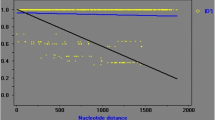Abstract
The study of the genetic polymorphism of pathogens is important for phylogenetic and biogeographic studies and, in the case of foodborne pathogens, to trace the origin of food infection. Since its discovery in 1972, the nonencapsulated species Trichinella pseudospiralis has been detected in mammals and birds, and human infection has occurred, in some cases resulting in death. We studied DNA polymorphism among ten T. pseudospiralis isolates from the Palearctic, Nearctic, and Australian regions, screening the sequences of nine genes [18sRNA, a random amplified polymorphism DNA derived sequence, mitochondrial cytochrome oxidase subunit I (COI), cytochrome P450, cynate lyase, epithelial fusion failure-1, and three unknown genes of Tp3, Tp8, and Tp26]. A high identity of sequence for the nine gene loci was obtained among the seven isolates from the Palearctic region and between the two isolates from the Nearctic region. Genetic identity analysis indicated the distinct polymorphism among the three geographical origins. To easily identify T. pseudospiralis genotypes, a polymerase chain reaction-restriction fragment length polymorphism analysis of COI gene was performed, and the results confirmed the DNA polymorphism within T. pseudospiralis, corresponding to the three regions of origin. We have named the three genotypes as “T. pseudospiralis Palearctic genotype” (code T4P), “Nearctic genotype” (code T4N), and “Australian genotype” (code T4A). To further investigate polymorphism among the nonencapsulated Trichinella species, the sequences of four gene loci (COI, P450, cynate lyase, and SB147D) of T. pseudospiralis, T. papuae, and T. zimbabwensis were analyzed, and the results showed high polymorphism among the three species, strongly supporting their classification as separate species.


Similar content being viewed by others
References
Dupouy-Camet J, Kociecka W, Bruschi F, Bolas-Fernandez F, Pozio E (2002) Opinion on the diagnosis and treatment of human trichinellosis. Expert Opin Pharmacother 3:1117–1130
Garkavi BL (1972) Species of Trichinella isolated from wild animals. Veterinariya 10:90–91
Kumar S, Tamura K, Nei M (2004) MEGA3: integrated software for molecular evolutionary genetics analysis and sequence alignment. Brief Bioinform 5:150–163
La Rosa G, Marucci G, Zarlenga DS, Pozio E (2001) Trichinella pseudospiralis . populations of the Palearctic region and their relationship with populations of the Nearctic and Australian regions. Int J Parasitol 31:297–305
Nagano I, Wu Z, Matsuo A, Pozio E, Takahashi Y (1999) Identification of Trichinella genotypes by polymerase chain reaction-restriction fragment length polymorphism of mitochondrial cytochrome c oxidase subunit I gene. Int J Parasitol 29:1113–1120
Nagano I, Wu Z, Nakada T, Matsuo A, Takahashi Y (2001) Molecular cloning and characterization of a serine proteinase inhibitor from Trichinella spiralis. Parasitology 123:77–83
Pozio E (2005) The broad spectrum of Trichinella hosts: from cold- to warm-blooded animals. Vet Parasitol 132:3–11
Pozio E, Murrell KD (2006) Systematics and epidemiology of Trichinella. Adv Parasitol 63:367–439
Pozio E, Zarlenga DS (2005) Recent advances on the taxonomy, systematics and epidemiology of Trichinella. Int J Parasitol 35:1191–1204
Wu Z, Nagano I, Takahashi Y (1998) The detection of Trichinella with polymerase chain reaction (PCR) primers constructed using sequences of random amplified polymorphic DNA (RAPD) or sequences of complementary DNA encoding excretory–secretory (E–S) glycoproteins. Parasitology 117:173–183
Zarlenga DS, Aschenbrenner RA, Lichtenfels JR (1996) Variations in microsatellite sequences provide evidence for population differences and multiple ribosomal gene repeats within Trichinella pseudospiralis. J Parasitol 82:534–538
Zarlenga DS, Rosenthal B, La Rosa G, Pozio E, Hoberg EP (2006) Post-Miocene expansion, colonization, and host switching drove speciation among extant nematodes of the archaic genus Trichinella. Proc Natl Acad Sci U S A 103:7354–7359
Acknowledgment
The authors wish to thank Simone Mario Cacciò for having performed the phylogenetic analysis with the software MEGA, version 3.1. This work was funded partially by a Grant-in-Aid for Scientific Research (17590370) from the Ministry of Education, Culture, Sports, Science and Technology of Japan and in part by the WP27 Trichimed of the MED-VET-NET Project of the European Union (No. FOODCT-2004-506122), the Slovak Research and Developmental Agency under the contract No. APVV-51-027605, and VEGA agency under the contract No. 2/7186/27. We would also like to thank the Matsumae International Foundation for providing fellowship covering the stay of Dr. Viliam Snabel at Gifu University Graduate School of Medicine during which a part of experiments was carried out.
Author information
Authors and Affiliations
Corresponding author
Rights and permissions
About this article
Cite this article
Wu, Z., Snabel, V., Pozio, E. et al. Genetic relationships among Trichinella pseudospiralis isolates from Australian, Nearctic, and Palearctic regions. Parasitol Res 101, 1567–1573 (2007). https://doi.org/10.1007/s00436-007-0677-6
Received:
Accepted:
Published:
Issue Date:
DOI: https://doi.org/10.1007/s00436-007-0677-6




